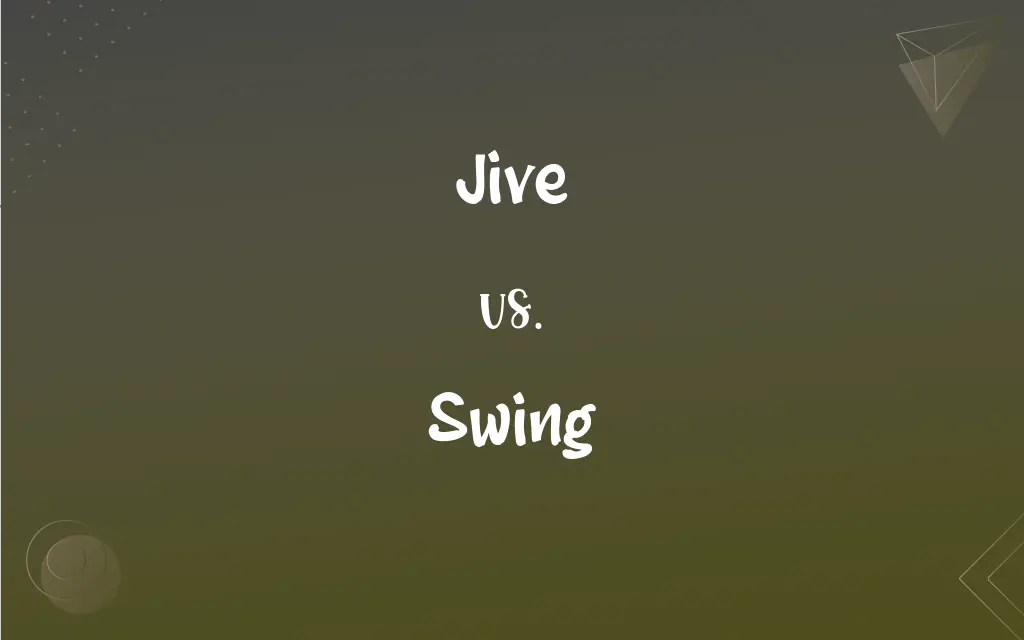Jive vs. Swing: What's the Difference?
By Janet White || Published on February 8, 2024
Jive is a lively, swing-era dance style known for its quick and complex movements, while swing is a broader category of rhythm-focused dances that emerged in the 1920s and 1930s.

Key Differences
Jive and swing are both dance styles that originated in the early 20th century. Jive, developed in the 1930s, is known for its lively and upbeat tempo, typically danced to big band and swing music. Swing, a broader term, refers to a group of dances that evolved with the swing style of jazz music in the 1920s and 1930s.
In jive, dancers often perform a variety of kicks and knee-lifting movements, making it an energetic and physically demanding dance. Swing, on the other hand, encompasses a range of styles, including Lindy Hop, Charleston, and Balboa, each with unique characteristics but all sharing a rhythmic and flowing nature.
Jive is characterized by a syncopated rhythm and a lot of chasses, a step pattern where one foot chases the other. Swing dancing, in contrast, is more diverse in its rhythms and steps, often including a mix of smooth and rhythmic movements.
The cultural context of jive is tied to the American swing era and was later popularized in Europe, especially in competitive ballroom dancing. Swing, as a dance form, is deeply rooted in African American culture and history, reflecting the evolution of jazz and American music.
Jive is a specific type of swing dance with a lively character and distinctive movements, swing refers to a wider category of dances with varied styles, all connected through their rhythm and historical origins in the swing era of jazz.
ADVERTISEMENT
Comparison Chart
Origin
Developed in the 1930s
Originated in the 1920s and 1930s
Tempo
Fast and lively
Can range from slow to fast
Key Movements
Kicks, knee lifts, chasses
Includes smooth, rhythmic movements
Cultural Context
Popular in American swing era, ballroom
Rooted in African American culture
Dance Styles
A specific type of swing dance
Encompasses various styles like Lindy Hop
ADVERTISEMENT
Jive and Swing Definitions
Jive
Music associated with jive dance.
The band played an upbeat jive number.
Swing
A type of rhythmic music inspiring swing dances.
This swing band really gets the crowd moving.
Jive
A lively dance style in swing music.
They won the contest with their energetic jive routine.
Swing
A genre of dance with roots in jazz.
Swing dancing brings people of all ages together.
Jive
Slang for deceptive or nonsensical talk.
Don’t give me that jive about being too busy.
Swing
A change or shift in opinion, situation, or tendency.
There’s been a swing towards remote work lately.
Jive
A term sometimes used to describe lively conversation.
They were all jiving at the party last night.
Swing
To move back and forth or from side to side.
The child loves to swing high on the playground.
Jive
A style within the swing dance family.
Jive is her favorite dance in the swing category.
Swing
In baseball, to attempt to hit a ball.
He took a powerful swing at the pitch.
Jive
Jazz or swing music.
Swing
To move back and forth suspended or as if suspended from above.
FAQs
What encompasses swing dancing?
Swing includes various styles like Lindy Hop and Charleston.
Where did jive originate?
Jive originated in the 1930s in the American swing era.
Can swing music be slow?
Yes, swing music can range from slow to fast tempos.
Are jive and swing the same?
No, jive is a type of swing dance, but swing is a broader category.
Is swing dance culturally significant?
Yes, it's rooted in African American culture and jazz history.
What is jive dancing?
Jive is a lively, swing-era dance with quick movements.
What age group enjoys swing dancing?
Swing dancing is popular across various age groups.
Are there slow jive dances?
Jive is generally fast-paced, but can be adapted to slower music.
What’s unique about jive steps?
Jive features energetic kicks and chasses.
Is swing dance easy to learn?
Swing can be accessible for beginners, depending on the style.
What music is best for jive?
Fast, upbeat big band and swing music suit jive dancing.
Can jive be danced competitively?
Yes, jive is popular in competitive ballroom dancing.
Can jive be danced solo?
While typically a partner dance, jive can be adapted for solo dancing.
How does swing music feel?
Swing music often feels rhythmic and lively.
Is jive part of social dancing?
Yes, jive is often enjoyed in social dance settings.
What's the attire for swing dancing?
Comfortable, loose clothing is common for swing dancing.
How diverse are swing dance styles?
Swing dance styles are quite diverse in steps and tempo.
Is jive included in swing dance classes?
Many swing dance classes include jive as part of the curriculum.
Is jive a partner dance?
Yes, jive is typically danced with a partner.
What skills are needed for swing dancing?
Rhythm, coordination, and sometimes acrobatic skills.
About Author
Written by
Janet WhiteJanet White has been an esteemed writer and blogger for Difference Wiki. Holding a Master's degree in Science and Medical Journalism from the prestigious Boston University, she has consistently demonstrated her expertise and passion for her field. When she's not immersed in her work, Janet relishes her time exercising, delving into a good book, and cherishing moments with friends and family.







































































